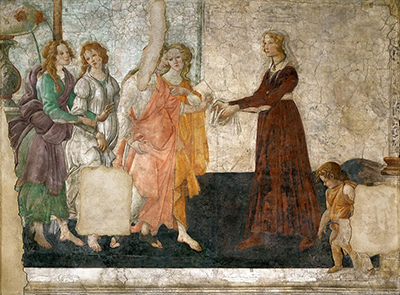Venus and the Three Graces Presenting Gifts to a Young Woman is another example from the career of Sandro Botticelli which captures Venus herself. That said, there has been some discussion over the precise identity of the women in this artwork, with some disagreements occurring over the centuries that have passed since.
This fresco is just under two metres in width, and just over two metres in height. It was actually removed from its original position and then mounted so that it could be moved elsewhere. It now resides in the Louvre in Paris, and it is one of the few Italian frescoes to have been moved in this manner, with many still remaining in their original locations. It has received a date of circa 1484, though in line with much of this artist's career, there are some questionmarks around what was the precise date of creation. Quite simply, very little documentation is available from this early artistic date and so one cannot be quite as sure about a particular year than we are about artists who followed in the centuries that followed. There are many different clues to be found within each painting that can help, though, such as the artist's travels around the country, the different patrons that he used as well as written correspondence that he might have had throughout his life.
This fresco is somewhat damaged as a result of being moved. The painting was perhaps given as a wedding present, but this has never been confirmed. Several different noble families have been mentioned as potentially commissioning Botticelli to put the artwork together. Venus and the Three Graces Presenting Gifts to a Young Woman was discovered as recently as 1873, making it one of the most recently uncovered works from the artist's career. This explains how many question marks around the painting remain unanswered though we do know that the piece was found in Villa Lemmi which lied close to property owned by Cosimo de Medici, who himself was highly influential within the arts as an important patron.
The artist would leave behind some truly iconic artworks by the end of his career. Highlights would include the likes of Mars and Venus and Madonna of the Magnificat, though a number of his creations were not discovered until years after his death. Efforts have been made over the years to protect his frescos as best as possible but for the artworks that were installed into buildings, this has proven far more difficult than for the artworks that could be easily moved. On the plus side, though, this has meant that many paintings from the Italian Renaissance actually still remain in their original positions and this helps the original work of each artist to be better understood. The influence of North European artists would eventually encourage Italians to use oils instead upon canvases, rather than the egg tempera but they are famous for their own innovations which would ultimately influence other artists all across the world.




